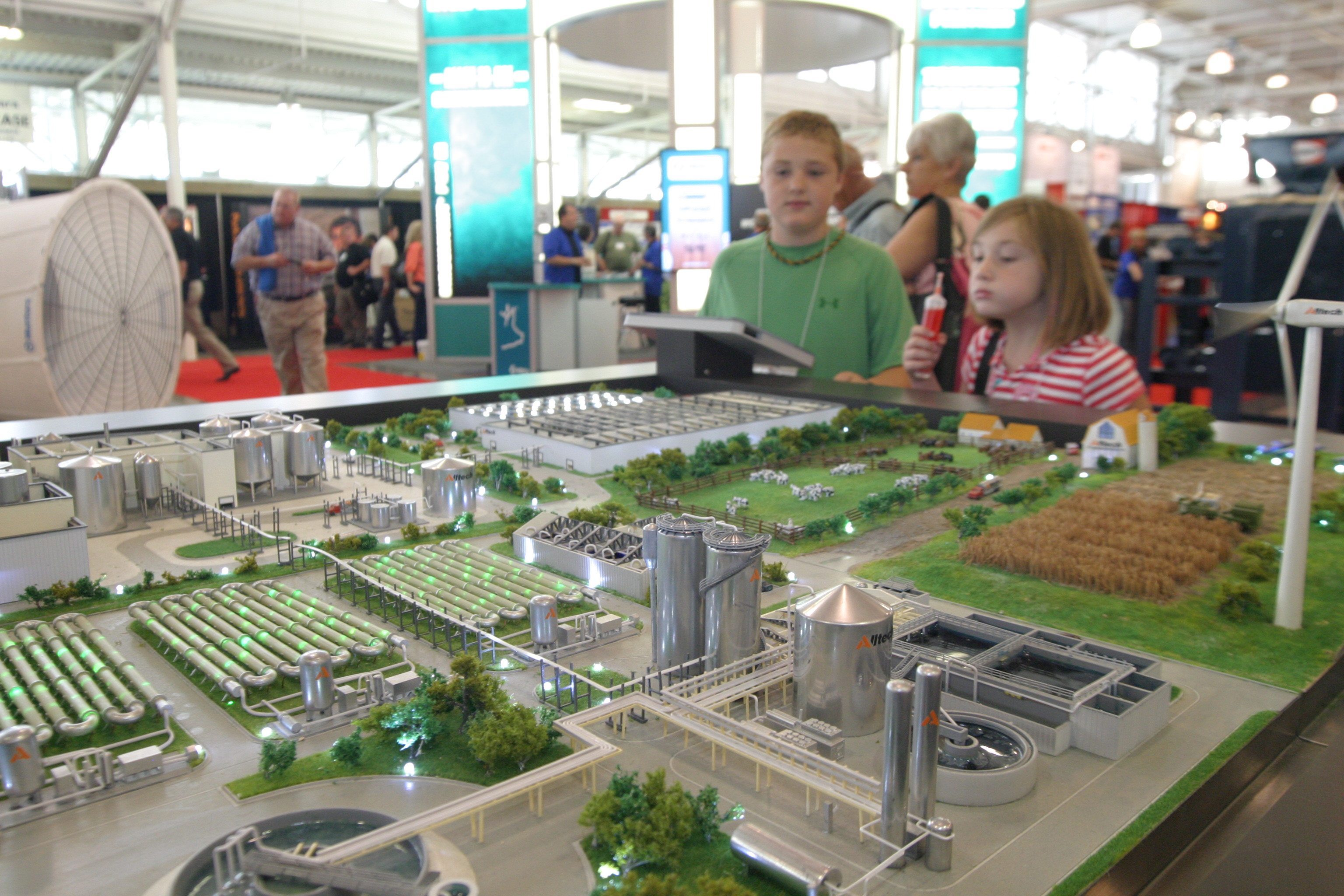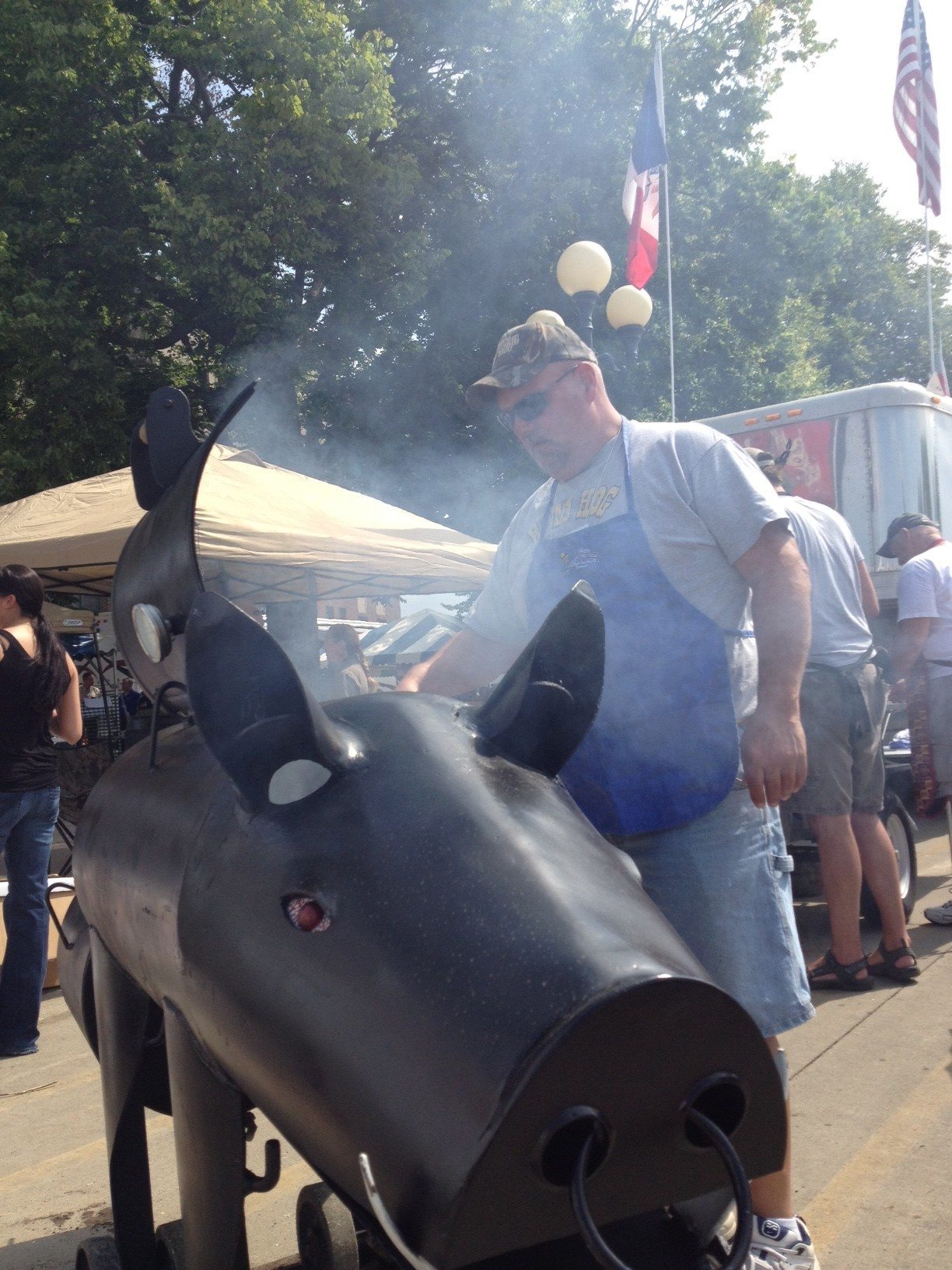I’m down at the World Pork Expo in Des Moines, Iowa. I’ll update this post throughout Wednesday, Thursday and Friday to keep you all up to date on what I’m seeing and hearing down here. Also, follow me on Twitter at @EdWhiteMarkets for useful and spurious and frequent commentary and updates from Des Moines.
(Above: an idealized Alltech Farm of the Future being peered upon by Cole and Ashley Igo of Marshall, Missouri, who were brought to the World Pork Expo by their grandparents.)
Read Also

Farmer ownership cannot be seen as a guarantee for success
It’s a powerful movement when people band together to form co-ops and credit unions, but member ownership is no guarantee of success.
A LIGHT DAY AT THE WORLD PORK EX, WHICH IS A RELIEF
Ahhhh, Friday’s here, which means I’ve got a half-day to be at the World Pork Expo and not be endlessly running from one seminar to another, from news conference to interview to speech. The Wednesday and Thursday are always pretty intense here for reporters, especially when some monster of an issue like gestation stalls for sows breaks out. By Friday the seminars and newsiest press conferences are done, and there’s actually time to walk around the trade show, eat some of the free pulled pork sandwiches being offered all around the place, visit the junior pig show and pop by the quarter horse show that always occur simultaneously with the Pork Expo, but has no direct connection. It’s a morning to decompress from the overwhelming weight of all the news, issues, data and debate that consumes a reporter’s time on the first two days.
In recent years here, and I have been covering this event for about a decade now, there has always been a massive issue erupting right at the time of the Ex. A couple of years ago it was H1N1, which slaughtered the hog market right before the event. The whole debate over “swine flu” versus “H1N1” was taking place, and a feeling of fear and outrage covered the event that year.
Then there was the aftermath of the world financial meltdown the year before that, which created a feeling of terror and anxiety as people tried to figure out if they could survive in the new market environment.
Before that there were debates about Country Of Origin Labeling, free trade agreements with Latin American countries.
So this year’s anxiety, debate and anger about the gestation stalls issue is really nothing different for the World Pork Expo. There’s always some massive issue in front of the North American industry.
The Ex seems a bit glum this year, and that might be because of the gestation stalls issue, or just because the expected spring rally turned into a spring rout and everyone here is making less money than they thought they might. Or it might just be because it has been an ugly half-dozen years for the hog industry, with the prolonged market slump, H1N1 and now gestation stalls making it far from a lighthearted industry.
I hope to find a happy, cheerier Pork Ex when I get there this morning.
Below are the things I’ve posted for the past couple of days.
DAY TWO BUSY BUSY
It’s a full day of seminars on disease, animal care, risk management for me, so I’m a bit late updating this post. Here’s what I heard this a.m.:
IMPACT OF FMD ON THE USA
Iowa State University ag economist Dermot Hayes discussed results of an analysis he and colleagues did on what would happen to US hog producers and the rest of the nation if Food and Mouth Disease broke out.
The conclusions are chilling. Pork prices would drop to near-zero immediately, then rebound, but the average price for the year following an FMD outbreak would be about 50 percent of pre-FMD levels. Over the next four years about 30 percent of U.S. production would have to be eliminated because the export market would disappear. Right now about one-quarter of U.S. pork is exported, so it’s a huge factor that can’t easily be lost.
For Western Canada it would obviously be a lot worse. Much more of our hog production is exported, so our prices and industry would implode if FMD broke out.
TRUCKING AND DRIVERS SPREAD PRRS
Butch Baker of Iowa State University told hog farmers that PRRS is mostly now spread by trucks, and that the trucker himself is particularly dangerous. People used to think birds spread a lot of diseases between barns, but it was probably always the truck. Generally, trucks aren’t sanitized even if they are cleaned, and cleaning one truck after another in unsanitized cleaning facilities can spread disease rather than control disease. A particular problem can be the driver, who can carry the disease around on his boots and clothes, or could park his truck beside other livestock vehicles. Heat treating trucks can kill most livestock viruses, as can having specific fleets of trucks for PRRS-positive and PRRS-negative herds. Turning the driver into a committed inspector of his own and the truck’s cleanliness and safety can be a major improvement.
Eastern Canadian hog industries driving U.S. to outrage and possible future actions
During the NPPC trade session provincial hog producer income support programs drew special attention and were mentioned as programs that NPPC wants removed before Canada can be allowed into the Trans Pacific Partnership.
The decision of the Ontario government to embrace the same sort of program that Quebec has been using for years – and driving the Yanks crazy for years – has made the American hog industry furious. They really seemed PO’d by these programs by the eastern hog producing provinces. Iowa State University economist Dermot Hayes told me it doesn’t make sense that two nations that have a free trade agreement can have provincial programs that are clearly trade-distorting.
I also spoke to the leaders of the Manitoba Pork Council, who I ran into right after speaking to Hayes, and they are similarly exasperated with the Ontario and Quebec industries, whose programs bring about the dangers of countervailing action or something else perilous for we of the West. This seems like an issue that’s going to grow now that Ontario has joined in Quebec in embracing this sort of program.
STANDING ROOM ONLY FOR 30/pigs/year/sow SESSION
It was standing room only – including me standing against the side wall – for a session on getting 30 piglets weaned per year per sow. A panel of producers and experts talked about barns that are producing 30 per year and ways of getting close to that target.
Much attention was paid to feed intake of the sow soon after farrowing and on returning sows to good health right after weaning. Lots and lots of questions from producers.
MEYER BEARISH ON CORN, BUT CAUTIOUS ON PIGS
Paragon Economics analyst Steve Meyer gave an outlook session at lunch that was bearish on corn prices (which should be good for hog producers’ margins) but cautious on the hog outlook. The reason for the caution on the hogs is that packer capacity will be pushed hard this autumn – the dreaded fourth quarter when things can go really badly – and there won’t be room for anything to go awry.
“It is going to get pretty tight,” said Meyer.
Pork prices have only risen in the past week to profitable levels again and that could get better if corn prices drop to $4 to $4.50 per bushel, which he sees as likely. But if a packer has some sort of unexpected shutdown, the pig price could swoon and eliminate any gains from cheaper corn.
REMARKABLE GAINS IN EFFICIENCY AND ENVIRONMENTAL IMPACT
A U.S. National Pork Board study looking at the environmental impact of U.S. pork production was just released here at the World Pork X. It finds that since 1959 carbon emissions have dropped 35 percent per pound of pork, that each pound uses 41 percent less water to produce, and that each pound takes 78 percent land less to produce.
A Pork Board leader said the trend of “continuous improvement” in all areas has led to this result. But he is worried that the recent drive by food companies to push producers into open housing systems could reverse the trend and cause less efficient production.
“I fear our industry might go backwards,” he said.
SIGHTS AND SOUNDS
The World Pork Expo is rife with sights, sounds and smells – mostly pleasant ones.
There are the cheery state pork princesses and the Iowa Pork Queen, who I met earlier today.
Then there is the omnipresent smell of wood smoke, used to make the thousands of smoked pork of many types served all over the place here.
OPEN HOUSING FOR GESTATING SOWS
Fascinating stuff on the gestating sow stall issue. A study done by Ron Plain of the University of Missouri found that of the 2/3 of U.S. sow production that responded to his survey, 17 percent now is in open housing. Those producers expect the amount to be up to 23 percent in two years time. That is “slightly higher than we anticipated,” said an NPPC leader at the press conference just now.
NPPC vice president Dallas Hockman said of the recent spate of fast food and grocery press releases calling for a move to open housing: “We’re tired of these announcements that are simply being made as a get out of jail free card.”
Hockman said open housing systems are many and varied, their costs are not well understood, and different situations must be studied. Much more research needs to be done on production systems before producers embrace open housing.
Ag lender Mark Greenwood said forced conversions are financially perilous, with working capital likely to be greatly depleted by paying for converting existing barns.
I asked Greenwood and Hockman about whether anyone will build new stall barns, considering the danger of forced future conversions. Hockman said some new stall barns are being built today, but most with the possibility of conversion contained within the designs. So convertible barns might become the way some producers deal with the great uncertainty over this issue. Others might just hold back from building anything new until all the dust settles on this issue, Hockman told me in an interview.
I must say that the number of 17 percent today and 23 percent in a couple of years shocked me. I had no idea there were already so many sows in open housing situations. To me, if this is a trend that continues, at a certain point there will be a tipping point at which time packers could go to demanding all-open housing pigs, if fast food and grocery chains demand. That’s the danger to producers owning existing stall barns and to anyone that builds new ones, methinks.
WHAT HAPPENED TO THE SPRING RALLY, AND GESTATING ON STALLS
Last night at the media reception for the World Pork Expo I managed to talk with a few U.S. pork industry folks, including National Pork Producers Council chief executive officer Neil Dierks, about the underlying feeling in the industry today.
The hog industry has had a tumultuous history for as long as I’ve been covering it (almost 18 years) and that shows no signs of abating.
Dierks told me the mood amongst U.S. producers is a bit glum right now not because people are losing money, but because the expected spring rally instead became a spring slump. Prices now for most producers are about break-even, so after a couple of years of paying-down debts piled up in the late 2000s price slump, producers are treading water. They aren’t falling behind, but aren’t getting ahead right now either. There are hopeful signs that some of the recent slump was due to the mild winter creating bigger pigs faster, and that glut of meat has mostly been worked down, but worries about export demand from places like China are still weakening the market.
The biggest issue overhanging the hog industry right now is the gestation stall issue, about which I and the Western Producer have written much. A phalanx of U.S. restaurant and grocery chains have recently come out publicly urging (or insisting) the hog industry move away from using gestation stalls, so the U.S. industry is trying to deal with that concern in a constructive manner. A gestation stall study is being released this morning here – including comments by famous hog industry analyst Ron Plain – so there is sure to be lots of media attention here this year.
From the research I’ve looked at, open housing systems appear to be able to be built and operated for about the same cost as a new stall barn system, but having to retrofit an existing facility is prohibitively expensive. If that’s true, to me it seems a no-brainer for producers with worn-out barns to build open housing barns when they replace old facilities, but that producers should be worried about forced conversions of facilities with years left of productive life. It’ll be interesting to see the results of the study being released today.


















